GaN and other compound semiconductors hold promise in power electronics in reducing energy consumption. GaN has a sweet spot in the power range of 50 watts to 10 kilo-watts (kW), and can be applicable across the automotive industry, UPS market, air conditioners, heat pumps, solar inverters, refrigerators, washing machines, USB-C chargers, and ICT power supplies.
In this report I have studied six of these segments – the automotive industry, air conditioners, solar inverters, refrigerators, washing machines, USB-C chargers – and have attempted to quantify the power savings till 2030. While the power savings are impressive, there is strong price resistance to GaN devices, and more work needs to be done on making GaN a commercially viable offering. Domestic manufacturing is an attractive path to this end.
At the same time, GaN offers the advantage of smaller size equipment. GaN is lighter and gives off less heat, and this may be the unique proposition to start with. In USB-C chargers, GaN is already successful because the smaller chargers are a real advantage. A similar case can be made for an onboard two-wheeler charger application, where currently limited onboard storage spaces are available.
For the six segments studied in this report, the highest energy savings are projected to be in Refrigerators: 8.5 tera-watt hours (TWh), Onboard chargers in Automotive industry: 7.22 TWh, and Air conditioners: 6.95 TWh. These segments account for 85% of savings out of the six focused segments.
Based on the Central Electricity Authority of India’s 6th version of the emission factor database, where 1 kWh of electricity translates to 0.85 Kg of carbon dioxide emissions, the total carbon dioxide savings are estimated to be 22 million metric tons (MMT), with the adoption of GaN across these 6 segments. In simple terms, these savings of carbon dioxide emissions are equivalent to the emissions of:
- 5,050,325 gasoline-powered passenger vehicles driven for one year
- 9,666,920,271.1035 liters of gasoline consumed
- 11,531,171,822.8136 kilograms of coal burned
- 2,760,679,857,685 of smartphones fully charged
The energy-saving impact of GaN in just the few market segments I studied is extremely consequential and will only be more substantial with wider penetration in these segments after 2030. There will be an even larger impact once power conversion based on GaN devices realize their full potential across all segments, and compound semiconductors (such as Silicon Carbide (SiC) and GaN) expand their penetration in applications above 10 kW.
Overview: The Indian Energy Sector
India has announced the target to be completely carbon neutral by 2070, and that India must meet 50% of its electricity requirements from renewable energy by 2030. India generated 1624 tera-watt hours of electricity in 2022-23, a growth of 8.87% from 2021- 221. Thermal power is the dominant source of electricity generation in India, using coal, natural gas, and oil as fuel. Approximately 75% of all electricity generation was accounted for by thermal power in 2021-222.
Even though India is extremely dependent on fossil fuels for electricity generation, the country has made substantial progress in promoting renewable energy sources. The government has actively encouraged investments in renewable energy projects to reduce the country’s carbon footprint. 23% of India’s total electricity generation is from renewable energy3. In 2022, Solar and Wind energy made up 92% of the total power capacity additions in India4. Coal accounted for only 5% of capacity addition in 20225.
To meet 50% of all energy requirements from renewable sources by 2030, 500 gigawatts (GW) of renewable energy capacity are planned to be installed, which can reduce a billion metric tons of carbon dioxide emissions6. Out of these 500 GW, 280 GW would be dedicated to solar energy plants7. Approximately 52 GW of battery storage capacity are also planned to be installed because solar energy generation is only available for a limited time every day.
The government has identified Solar parks at Fatehgarh, Bhadla and Bikaner in Rajasthan, Khavda in Gujarat, and Anantapur and Kurnool in Andhra Pradesh8.
India’s Current Energy Production9:
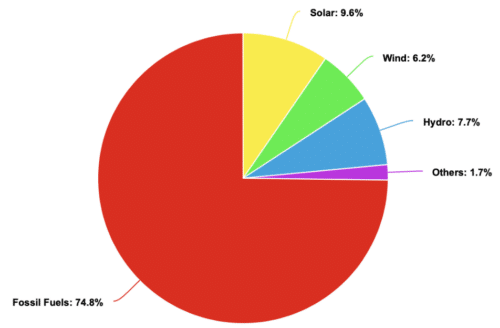
India’s Projected Energy Production In 2030:
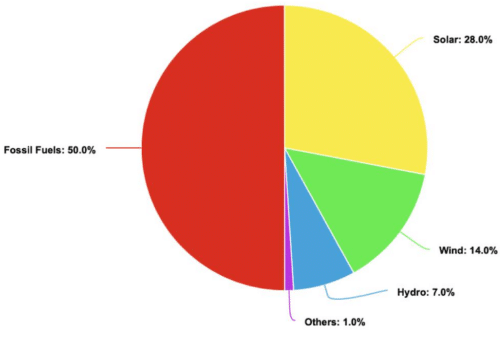
Overall, it is clear that solar energy will be the prominent renewable energy source out of the 50% by 2030, followed by Wind and Hydro. Of the fossil fuel sourced power segment, coal will be the majority10.
India could well supply renewable energy to its neighbors in the future by linking up its national grid. This intent has just been announced by the Government of India and could well become a reality if India achieves its renewable energy potential.
Gallium Nitride (GaN) and India
While India is approaching its power generation roadmap from a transition to renewable energy, it should also focus on reducing energy consumption through energy efficient technologies. India made rapid strides in mandating all lighting to be LEDs, and the use of inverter technology in consumer appliances is increasing in the country too, but there are lesser explored areas that will also yield significant energy savings. Increasing the usage and prevalence of compound semiconductors like gallium nitride (GaN) and silicon carbide (SiC) is one such area. GaN is most efficient in the voltage range from 50 W to 10 kW, SiC is currently most efficient above 10 kilowatt11.
This report will focus on applications of GaN in onboard chargers for electric vehicles, solar inverters, inverters air conditioners, refrigerators, and washing machines, and USB-C chargers. Public streetlight projects, defense industry, UPS market, aerospace, and ICT power supplies are other applications of compound semiconductor devices.
Gallium nitride (GaN) is a semiconductor material that has gained significant attention and adoption in various electronic devices, particularly in high-power and high- frequency applications. It is a compound made up of gallium (Ga) and nitrogen (N) atoms and is known for its unique properties that make it suitable for certain semiconductor applications. GaN has high electron mobility, which means that electrons can move through the material more quickly, enabling high-frequency operation. This property makes GaN devices suitable for high-frequency and high-speed applications. Moreover, GaN devices can operate at higher voltages and temperatures, making them ideal for high-power applications12. Compared to alternatives such as silicon and silicon carbide, GaN is more efficient and generates less heat leading to smaller and lighter systems and in many cases enabling solutions that might not be viable with conventional silicon technologies – good examples are medium to high power USB-C chargers (>30W) and onboard chargers for electric vehicles. .
India can be an attractive country for GaN production. As per the Indian Bureau of Mines, India’s total bauxite resources are estimated to be around 3,908 million tonnes13. Bauxite is primarily used as a source of aluminum metal and various aluminum-based products. India is the third largest producer of aluminium, and gallium is a byproduct of aluminum extraction. The country has significant reserves of gallium, and access to local gallium sources can provide a competitive advantage in terms of reduced production costs and a stable supply chain.
The states of Odisha, Andhra Pradesh, Gujarat, Chhattisgarh, and Maharashtra are among the major bauxite-producing regions in India. Recently, a large compound semiconductor producing FAB project has been approved in Uttar Pradesh14.
In 2022, the worldwide total addressable market (TAM) size for gallium nitride semiconductor devices reached USD 2.17 billion, and it is projected to grow at a compound annual growth rate of 25.4% from 2023 to 2030. The market’s expansion is primarily driven by the superior benefits provided by GaN semiconductor devices compared to traditional silicon devices, which have long been utilized in the production of in consumer electronics products like smartphones, computers, cameras, and televisions along with industrial uses.
The United States and China are the two leading countries in the production of gallium nitride (GaN) semiconductor devices. Both countries have been actively investing in research, development, and manufacturing facilities for GaN-based technologies. Companies from the United States such as MACOM (MTSI on Nasdaq), Qorvo (QRVO on Nasdaq) for RF applications, and Transphorm for power conversion applications (TGAN on Nasdaq) produce the most GaN15. Infineon Technologies (IFNNY and IFNNF on OTC markets) from Germany is also a global leader, acquiring GaN systems from Canada recently16.
The positive economic reasons for production in India include local availability of bauxite, the relatively lower labor costs compared to developed countries. This cost advantage can make GaN production more cost-effective for businesses. In addition, the Indian government has been creating a healthy ecosystem for research and development, including initiatives to boost domestic semiconductor manufacturing. These incentives can include tax benefits, subsidies, and infrastructure support, making it more conducive for businesses to invest in GaN production in India.The central government offers a 50% investment subsidy on selective semiconductor projects. State governments can offer an additional 20% subsidy.
This report aims to provide a comprehensive overview of six segments consuming a significant proportion of India’s power and how each of these segments would be impacted – benefit with increased energy efficiency, or not have a meaningful impact on savings – with the addition of gallium nitride (GaN) in their semiconductor power devices. The six segments are:
- Automotive Industry- Onboard Chargers for two, three, and four wheeler EVs
- Air Conditioners (HVAC)- Window Air Conditioners and Split Air Conditioners
- Refrigerators- Single and Double door, inverter based refrigerators
- Washing Machines- Fully automatic, top and front loading
- Consumer charging equipment- USB C chargers for phones, laptops, and tablets.
- Solar inverters- Rooftop and small solar installations
The Automotive Industry
As of 2022, India holds the position of the fourth-largest automotive producer globally and ranks third for the largest automobile market. In terms of industry valuation, India secured the fourth spot worldwide. In the same year, India surpassed Japan and Germany in automobile sales, securing the third position globally.
The Indian automotive industry’s present value exceeds $100 billion, contributing 8% to the country’s total exports and accounting for 2.3% of India’s GDP. Remarkably, despite the challenges posed by the COVID-19 pandemic, India experienced impressive growth, selling 3,759,398 vehicles in 2021. This represented a huge 26% increase compared to the previous year, making India the only country among the top five to achieve such double-digit growth.
The government of India has signed up for the global EV30@30 campaign. The EV30@30 campaign sets the Indian government a target to reach a 30% sales share for EVs by 203017. According to data on the Government’s Vahan website, approximately 9,89,000 EVs were registered with regional transport offices in 2022 alone, indicating a more than threefold growth from 2021 already18.
Minda, Pune informs that the volume of two wheelers (both low and high speed) added to the market every year is projected to increase from 1 million in 2023 to 10 million in 2029. Three and four-wheeler EVs added per year are expected to be over 1 million by 2029.
The application for GaN in the automobile industry is in onboard chargers. While GaN can be used in the drive mechanism in auto-segments, in this report, we have considered only the application for onboard chargers. The reduced size of onboard chargers is of significance in the market due to currently limited onboard storage spaces.
The government has extended the Faster Adoption and Manufacturing of Hybrid and EV (FAME) II scheme from 2021 till 2024. This scheme aims to create battery and EV manufacturing capacity. The extension also added a component for charging infrastructure deployment, amounting to 10% of the funding allocation19.
An onboard charger (OBC) is a power electronics device that converts AC power from an external source, like a residential outlet, to DC power to charge the EV’s battery pack20. Onboard chargers are also universal, all EVs usually have a standard level 1 (slow) and level 2 (fast) charging plug. Variations are rare, and if they do exist, the OBC is able to automatically adjust to the correct regional standards based on data received from the EV supply equipment (EVSE) controller or vehicle controller, hence, this is no concern21.
Currently, every EV sold comes with an onboard charger. Therefore, the volume of onboard chargers added to the market will increase at the same rate as Evs do. There is speculation, however, that onboard chargers will not be supplied with an EV once public charging stations become easily accessible in India. India is on track to have only 10,000 public charging stations by 2025, so for an onboard charger to not be provided with the car is unlikely to happen till 203022.
Roadmap of onboard chargers in India:
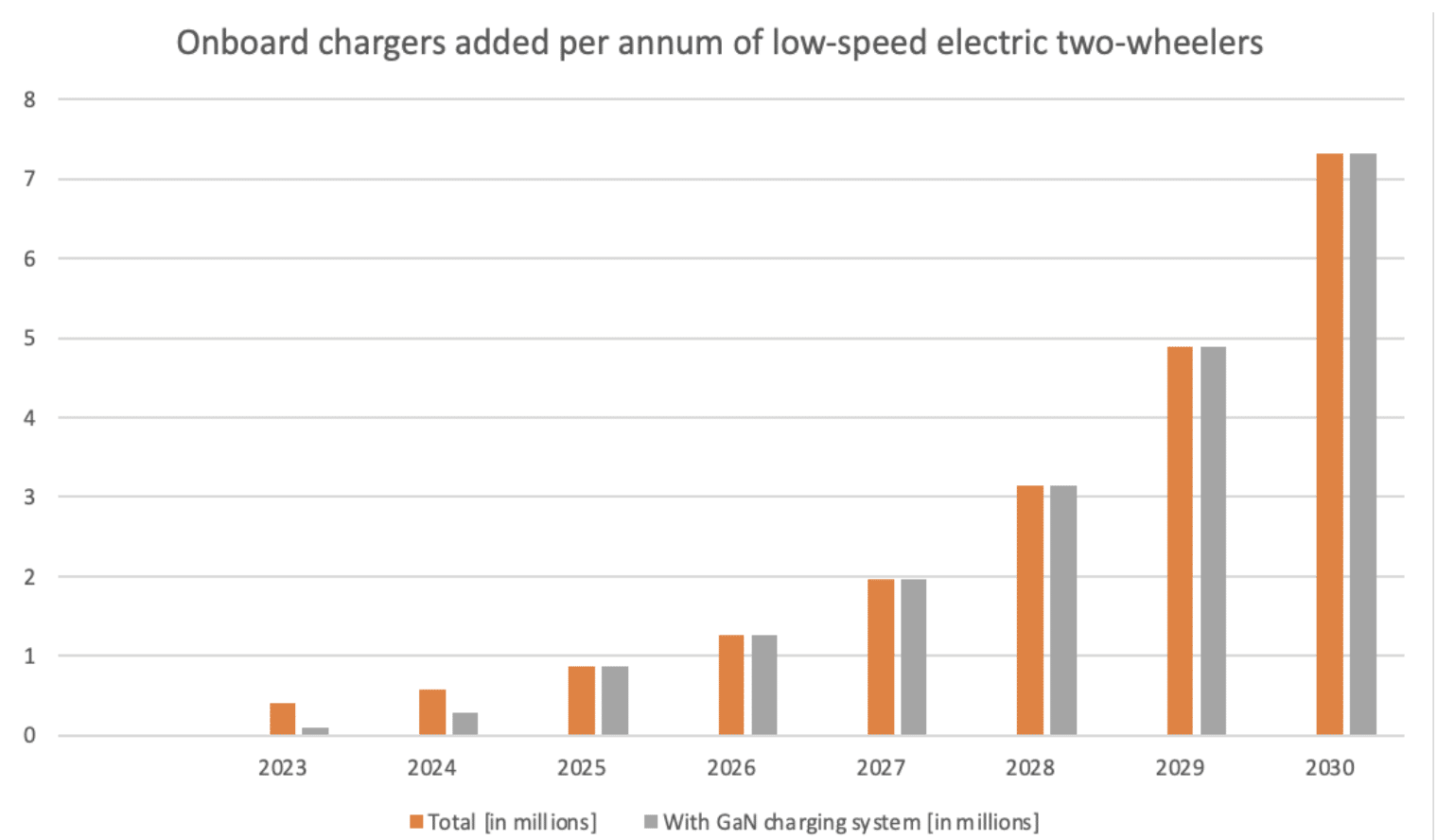
400,000 low-speed electric two-wheelers are projected to be added to the Indian market in 2023, with 100,000 vehicles provided with a GaN charging system. This is expected to grow to 7.33 million new low-speed electric two-wheelers being added to the market in 2030, with 100% provided with a GaN charging system.
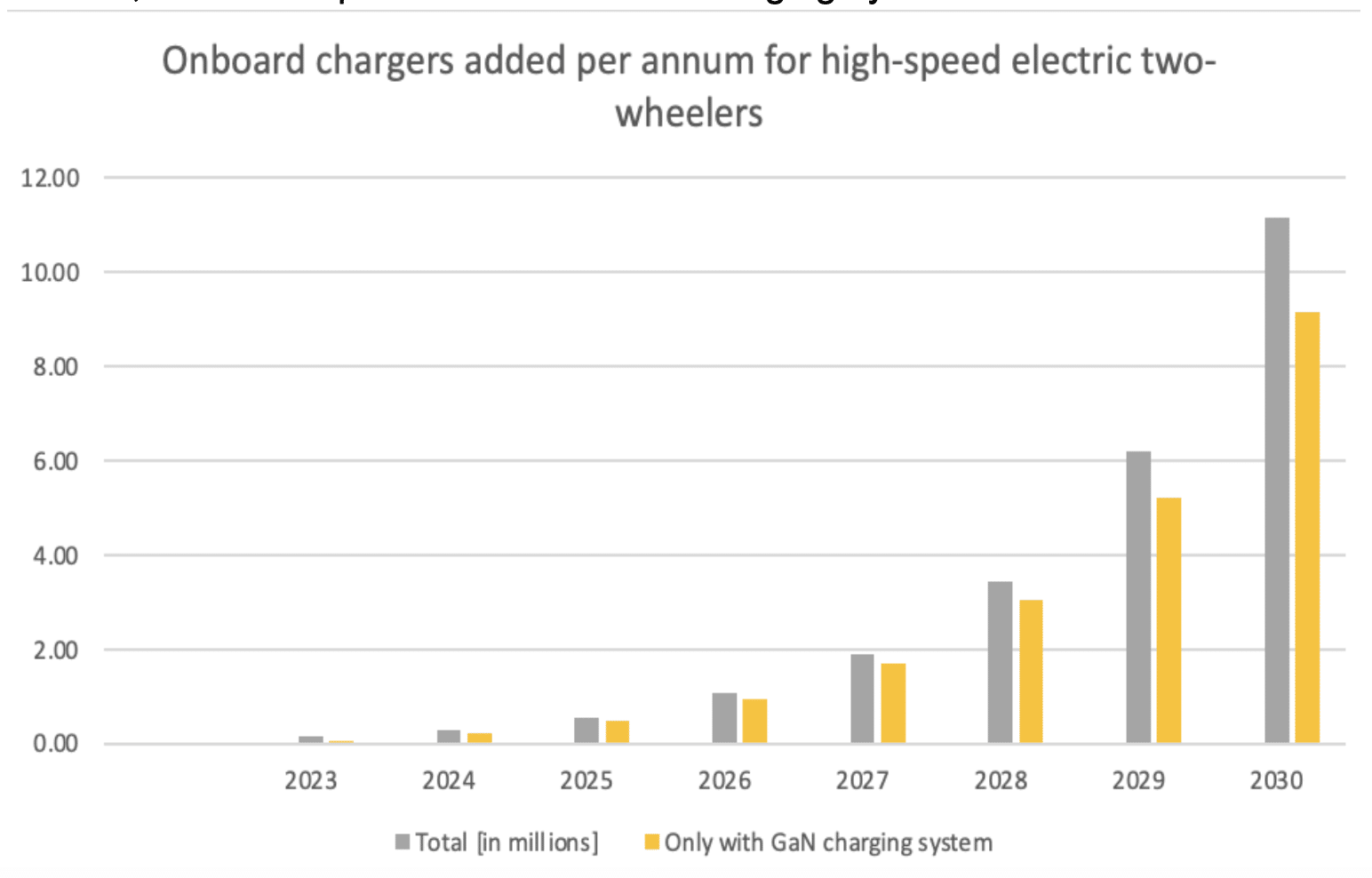
160,000 high-speed electric two-wheelers are projected to be added to the Indian market in 2023, with 6,000 vehicles provided with a GaN charging system. This is expected to grow to 11.16 million new low-speed electric two-wheelers being added to the market in 2030, with 9.16 million of those provided with a GaN charging system.
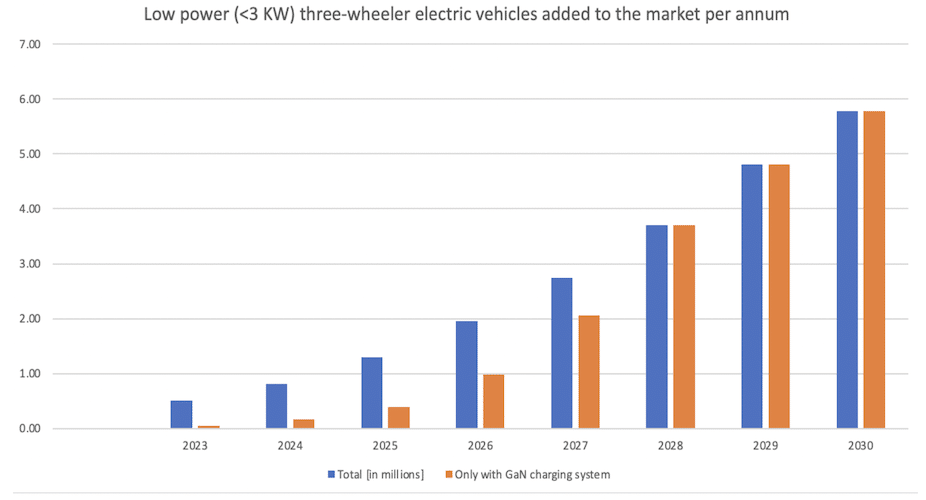
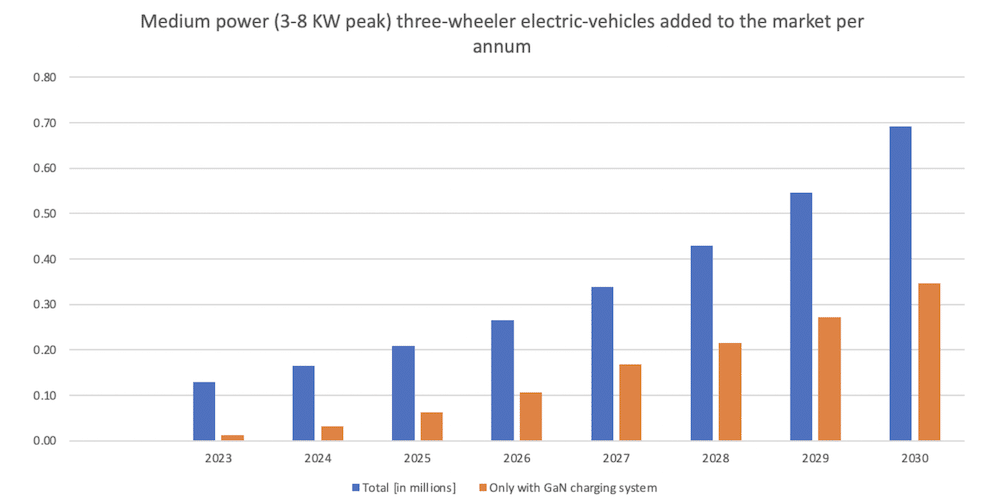
Electric three-wheeler vehicles added to the market per year are projected to grow from 0.6 million in 2023 to over 6 million in 2030. In the low power range, 100% of vehicles
will be provided with GaN charging systems in 2030, and about 50% of medium power vehicles be provided with GaN charging systems in 2030.
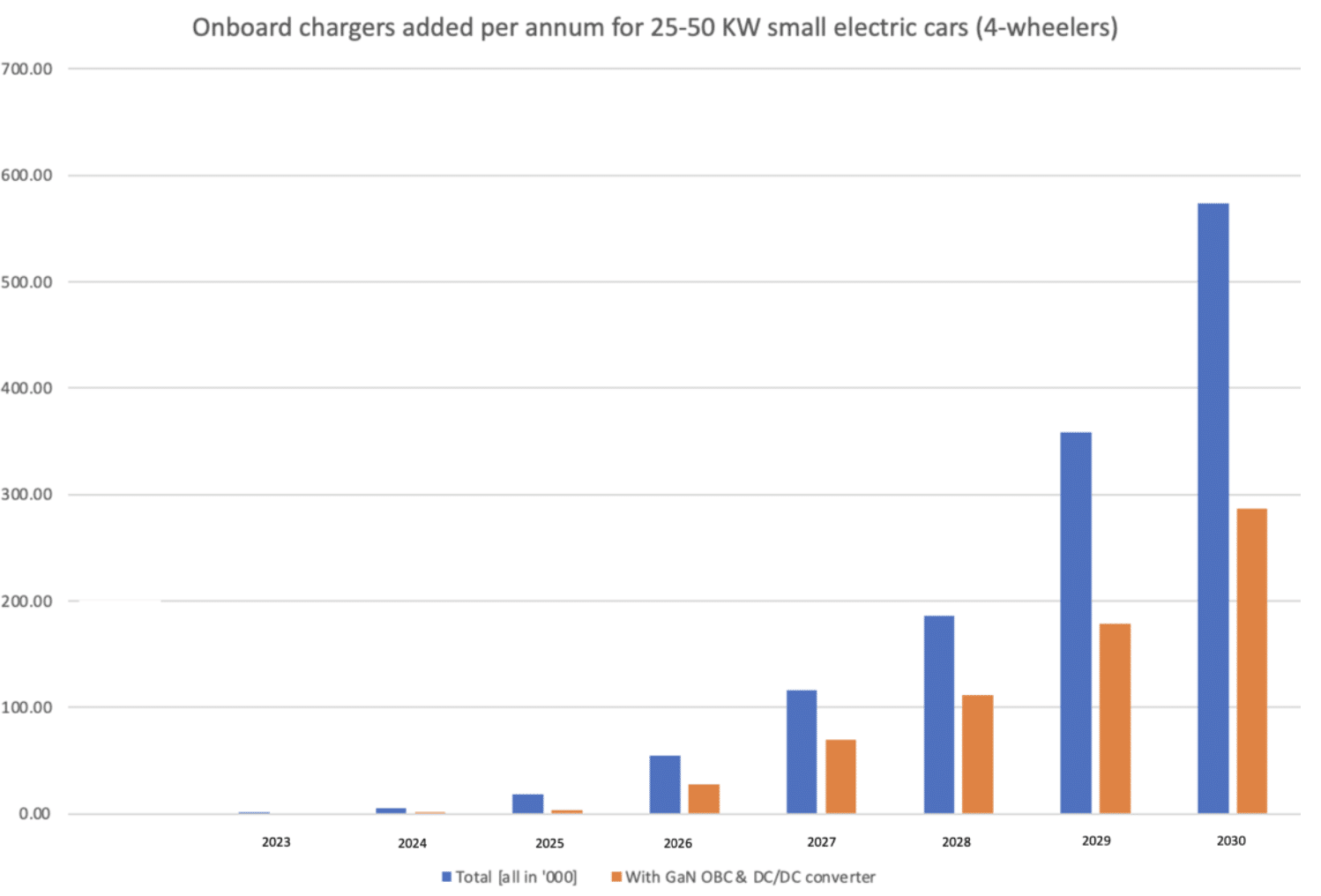
20,000 commercial electric four-wheelers, 25-50 kW small cars, are projected to be added to the Indian market in 2023, with 2000 vehicles provided with a GaN charging system. This is expected to grow to 955,000 new, small electric four-wheelers being added to the market in 2030, with 573,000 provided with a GaN charging system.
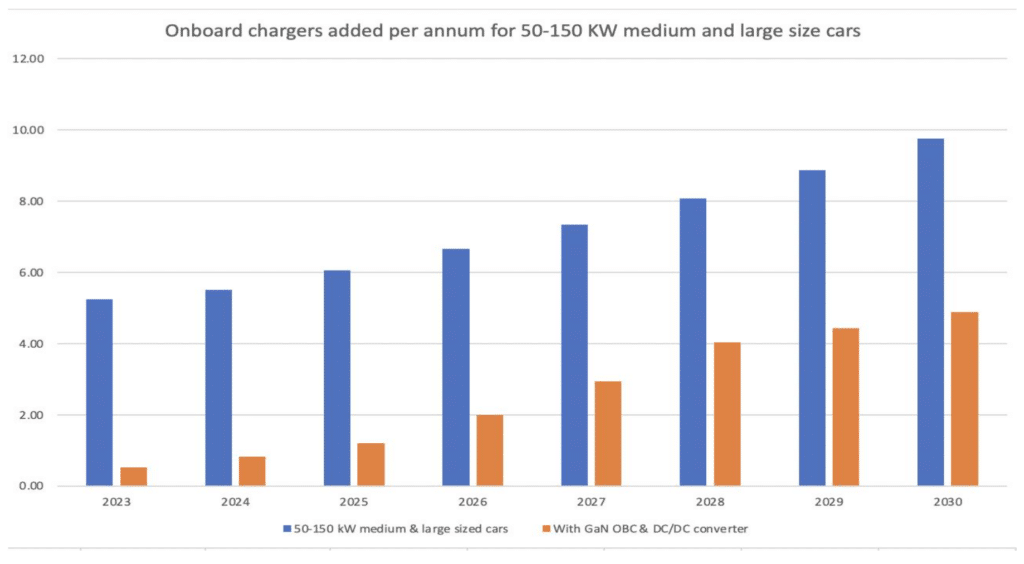
GaN will substitute MOSFETs in the OBC. Firstly, the device rating for 220 V OBCs is well within the range of 650V GaN devices. Secondly, this is a good application area for GaN because energy conversion can be done at higher frequencies, enabling lighter and compact transformers to be used. This is because switching losses for GaN are lower than for other technologies. Also, there is minimal reverse recovery losses: losses that occur when a current flows through a diode in reverse direction. These occur with SiC MOSFETs.
GaN based onboard chargers are projected to save between 6 and 15% more energy than its alternatives across low and high speed two wheelers, three wheelers, and four wheelers. The total savings across low and high speed two wheelers, three wheelers, and four wheelers, with GaN charging systems and drives, add up to 7.22 TWh. According to the CEA’s 6th version of the emission factor database, 1 kWh of electricity translates to 0.85 kg of carbon dioxide emissions23. 7.22 tera-watt hours of electricity saving, therefore, translates to saving approximately 6,137,000,000 Kg of carbon dioxide emissions. This is 6.13 MMT of CO2 emissions saved.
The costs of GaN are higher than silicon for comparable headline volt and amp ratings, however, the efficiency gains in this OBC application will deliver overall cost savings. These savings appear from lower energy bills on the supply-side. For the manufacturer, handling a GaN OBC is easier due to the reduced weight and size of the charger. For the consumer, battery charge time is shortened in a GaN OBC. The compact and lighter OBC also helps to maximize cabin space and driving range for the consumer.
Air Conditioners (HVAC)
India’s energy efficiency policies have spurred significant enhancements in air conditioner (AC) energy efficiency and accelerated the adoption of highly efficient inverter technology, as indicated by data from the Bureau of Energy Efficiency (BEE), Ministry of Power. The government’s India Cooling Action Plan (ICAP) aims to deliver an integrated approach to cooling across sectors, including reducing cooling demand, transitioning to alternative refrigerants, enhancing energy efficiency, and promoting better technology options over a 20-year period24.
In addition to these government initiatives promoting inverter air conditioners, there have been a multitude of changes in the lifestyle of the average Indian consumer. These changes include the rise of nuclear families, single-person households, and job migration25. The changes have created a growing need for accessible and convenient products that reduce the time and effort spent on everyday chores. The primary factors fueling the market’s growth are the increasing disposable incomes and convenient access to credit, resulting in greater purchasing power. While the urban population accounts for two-thirds of the total revenue, the rural residents are also playing a significant role in driving the industry’s expansion26.
More and more people are buying ACs in rural India. Both increased urbanization and electrification in rural areas are consistently growing, and with them, so is the demand for ACs. With increasing affordability, digital penetration, and rising aspirations from the consumer, the HVAC industry is growing with a focus on energy efficiency27. Increasing temperatures due to climate change and usage of online delivery and shopping mediums have too contributed to greater demand for ACs.
Manufacturers like Amber, where the first inverter window AC was developed in India, are keeping up with these changing economic conditions28. Amber has developed 5.2 ISEER model- India’s Highest Energy Efficient Inverter AC (split AC) in the 1.5-ton segment29. Amber’s Research and Development Head, Sahil Kamboj explains that the 1.5-ton AC gathers the largest revenue in India. Consumers prefer this size due to its compactness, ideal to be used in large homes or smaller apartments. This size also incorporates inverter technology, which reduces electricity bills. Kamboj informs that consumers use the 1.5-ton split AC for an average of 10 hours a day during 9 months of the year, with most split ACs consuming 1.5 kW per hour.
Roadmap of Window and Split ACs In India:
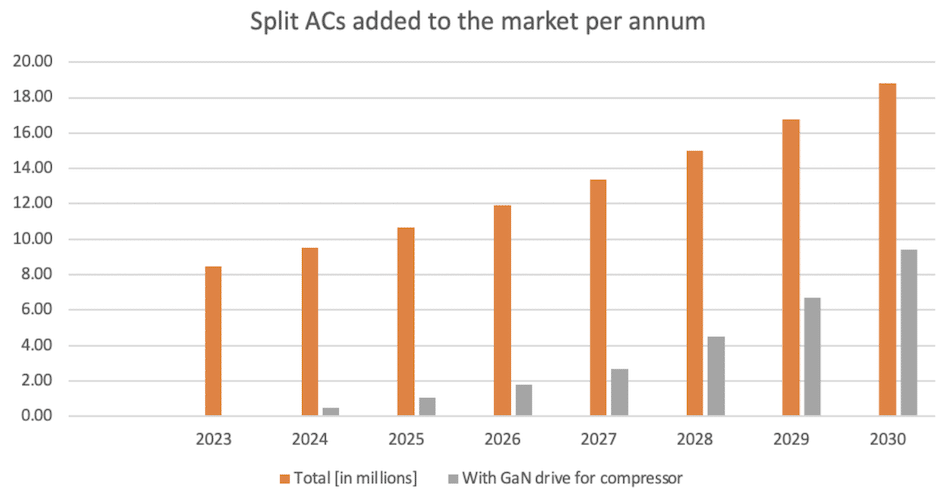
Split ACs added to the market are growing at a rate of 12% a year. The volume of the market in 2023 was 8.5 million. Kamboj mentions that GaN will be added via a current point in the generator of the device and will soon be introduced in inverter ACs as the market evolves rapidly. Split ACs with GaN drive in their compressors are projected to be 5% of the market in 2024 – 480,000. This number is expected to become 50% – 9.4 million – of the total of 18.8 million in 2030. 107.17 terawatt hours of energy will be consumed by Split ACs from 2023 to 2030. The savings with GaN here will be 5%, 5.39 terawatt hours. The savings will be on the switching side and are on top of the savings that already occur when using inverter technology (with silicon) – 20% with inverter technology and 25% (additional 5%) with GaN. GaN saves 5% more than silicon here.
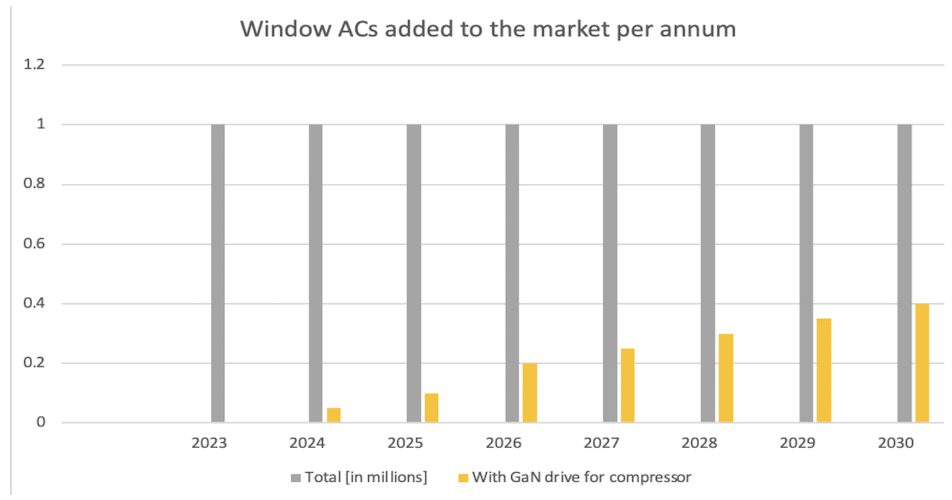
The market volume of window ACs and on/off split ACs (no inverter technology) is projected to stay constant at 1 million units added per year till 2030. Like for Split ACs, GaN drives will be introduced in 2024 and will cover 5% of the market – 5000 models. This number is expected to become 40% – 400,000 models – of the 1 million added in 2030. 5.20 TWh of energy will be consumed by window ACs from 2023 to 2030. The savings with GaN here will be 30% more than silicon at 1.56 TWh.
Even though their manufacturing process is capital-intensive, Amber’s factory in Greater Noida employs over 450 people. From people inspecting machines operating, to engineers conducting inverter drive experiments in research and development, to testing products in random samples, there are a wide range of employment opportunities offered by the company that require different skill sets.
Companies like Amber have imported machinery from South Korea and China to manufacture, and these are expensive investments. Kamboj explains that the machines only need one minor program change to accommodate the presence of GaN in circuits, thus, there is scope to export from India with the accessibility of natural resources in the country to use GaN.
The 5.39 TWh savings with split ACs translate to 4,581,500,000 Kg of carbon dioxide emission savings from 2023 to 2030.
The 1.56 TWh savings with window ACs and on/off split ACs(?) translate to 1,326,000,000 Kg of carbon dioxide emission savings.
A total of 5,907,500,000 Kg, or 5.9 MMT of Carbon dioxide emissions can be saved from 2023 to 2030 with the adoption of GaN.
Refrigerators
The government, along with NGOs and other organizations, has run awareness campaigns to educate consumers about the benefits of inverter refrigerators and other energy-efficient appliances. These campaigns emphasize how energy-efficient appliances can save money and contribute to a greener environment. The Bureau of Energy Efficiency (BEE), most notably, has introduced the star rating program for appliances, including refrigerators30. Inverter refrigerators with higher star ratings are more energy-efficient, and consumers are encouraged to choose models with a higher number of stars to save energy and reduce electricity bills. Inverter refrigerators are labeled with energy efficiency information to help consumers make informed choices about their purchases. The labels provide details about the appliance’s energy consumption, allowing consumers to compare different models and select more energy- efficient ones.
As a result of the government’s awareness campaigns and BEE’s programs, Indian consumers have become energy conscious31. There has been a clear transition to inverter refrigerators due to increased understanding of overall cost saving with an inverter device, and that a higher upfront cost is worth it, being recovered when the refrigerator is used32.
The Indian government has offered financial incentives, such as rebates or subsidies, to encourage consumers to buy energy-efficient appliances, including inverter refrigerators33. These incentives aim to make energy-efficient products more affordable for consumers.
Manufacturing inverter refrigerators can be more complex compared to conventional non-inverter models due to the additional components and technology involved. However, the advancements in manufacturing processes, the benefits of inverter technology, extensive government support, and increasing market demand make it a worthwhile endeavor for many manufacturers. In fact, the impact on demand of the refrigerators was overstated and India had a greater capacity of refrigerators than its demand. Therefore, Indian manufacturers had requested the government to impose importing restrictions on refrigerators in June, 202234. The market for inverter refrigerators is growing by 8% every year in India, about the same as the Indian GDP, and the potential for GaN is huge.
Inverter refrigerators are classified into type types: single and double-door refrigerators. Single-door refrigerators make up 70% of the market of refrigerators, while double-door refrigerators make up the remaining 30%.
Roadmap of single-door inverter refrigerators in India:
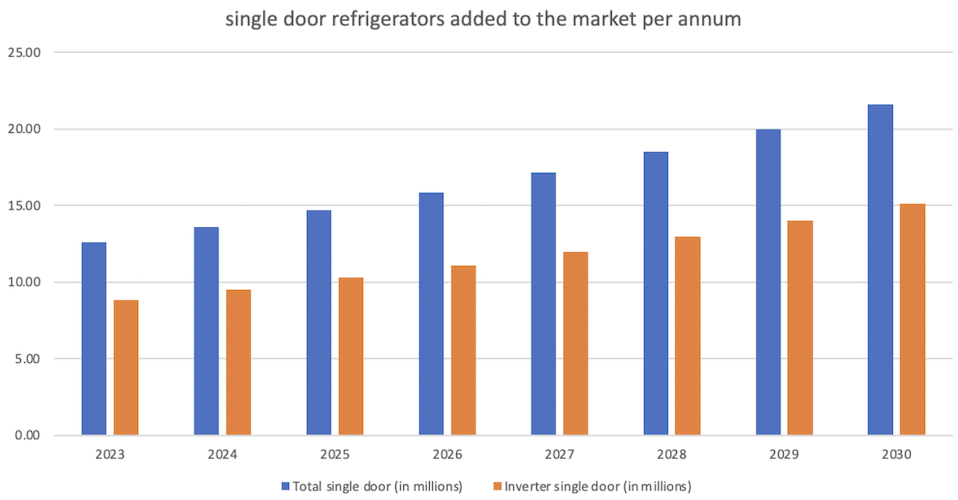
The volume of all single-door refrigerators added to the market in 2023 was 12.6 million, and out of these, 70% or 8.82 million were inverter based. By 2030, single door refrigerators added to the market per annum will increase to 21.59 million, and inverter based single-door refrigerators will exceed 15 million.
Roadmap of double-door inverter refrigerators in India:
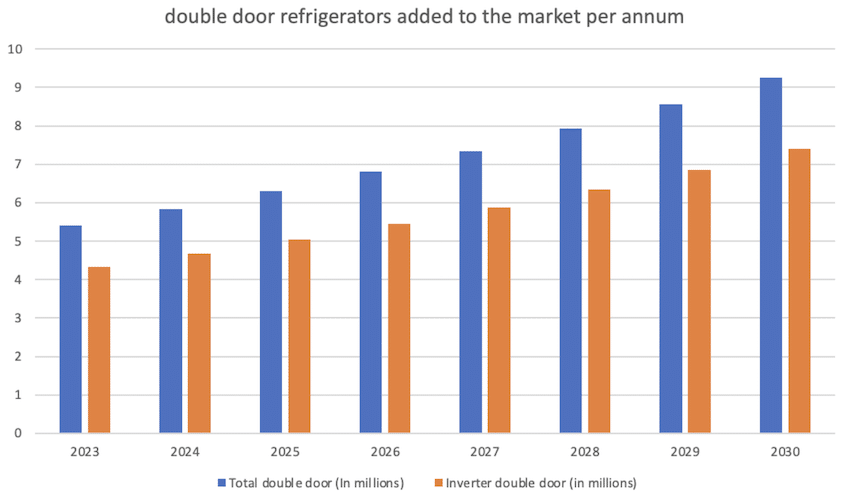
Double door refrigerators added to the market in 2023 were 5.4 million. 80% of all double-door refrigerators were inverter based, totaling 4.3 million. By 2030, double-door refrigerators added to the market per annum will exceed 9 million, and inverter based double-door refrigerators will be 7.4 million.
In an inverter refrigerator, GaN technology can be utilized in the transistors or switches responsible for converting alternating current (AC) to direct current (DC) (the power factor correction circuit) followed by the inverter circuit converting DC to AC to drive the compressor.
According to the star rating program of The Bureau of Energy Efficiency (BEE), the average single-door inverter refrigerator consumes 228 kWh of energy per year. The total energy consumption by single-door refrigerators would be over 21 TWh by 2030. Savings with inverter technology are over 4 TWh (20%), and savings with GaN included are over 5 tera-watt hours (25% of total consumption, and 5% more than with only inverter technology).
The average double-door inverter refrigerator consumes 275 kWh of energy per year. The total energy consumption by single-door refrigerators is over 12.5TWh by 2030. Savings with inverter technology are over 2.5 TWh (20%), and savings with GaN included are over 3 TWh (25% of total consumption, and 5% more than with only inverter technology).
Like in HVAC, savings with using GaN devicesare on the switching side in both single and double-door refrigerators. The 5.35 TWh savings of energy consumption in single- door refrigerators translates to 4,547,500,000 Kg of Carbon dioxide emissions saved. The 3.15 TWh savings of energy consumption in double-door refrigerators translates to 2,677,500,000 Kg of carbon dioxide saved.
A total of 7,225,000,000 Kg, or 7.225 MMT of carbon dioxide saved across both double door and single door refrigerators with the introduction of GaN.
Washing Machines
The washing machine market in India has been experiencing substantial growth over the past few years. Rapid urbanization has resulted in smaller living spaces and less access to traditional laundry methods, and with a growing number of working individuals
in India, the demand for labor-saving devices like washing machines has risen35. Disposable incomes increased, leading to a rise in consumer spending on appliances like washing machines. Manufacturers have also been introducing technologically advanced washing machines with features like automatic settings, energy efficiency, and smart connectivity, which attract consumers36.
Like for refrigerators, the Indian government has introduced initiatives to promote washing machines. Programs such as the Bureau of Energy Efficiency (BEE) star labeling system encourage consumers to choose more eco-friendly and energy-saving models. According to the BEE, one unit of a fully automatic washing machine consumes 120 kWh of power a year37.
Several major brands compete in the Indian washing machine market, including Samsung, LG, Whirlpool, IFB, Bosch, Godrej, Panasonic, and Haier, among others38. These brands offer a range of models catering to different price segments and consumer preferences. There are currently two distinct types of washing machines in India: Semi-Automatic Washing Machines and Fully Automatic Washing machines.
Semi-Automatic Washing Machines are popular in India due to their relatively lower cost compared to fully automatic models. They require some manual intervention during the washing process. On the other hand, fully automatic machines are further divided into front-load and top-load categories. They offer more convenience, as they handle the entire washing process completely automatically.
A fully automatic top-loading washing machine rotates the tub at approximately 750-800 cycles per minute. On the other hand, a semi-automatic washing machine spins the tub at a faster rate.
GaN has a strong application in fully automatic washing machines, both top and front loading. Their voltages range from 110 volts to 400 volts, a strong compatibility with GaN39.
Out of the 4.5 million washing machines added to the Indian market in 2023, 2.7 million are inverter-based (60%). Vishal Goyal, associate vice-president and head of Dixon Green India’s washing machine R&D facility, explains that the washing machines added to the market per annum will grow at a rate of 8% each year till 2030, but the composition of inverter-based washing machines will increase from 60% to 90% by 2030. In 2030, there will be a total of 7.71 million washing machines added to the market, and 6.94 million washing machines will be inverter-based. The semiconductor these inverter-based washing machines currently rely on is Silicon.
Roadmap of washing machines in India:
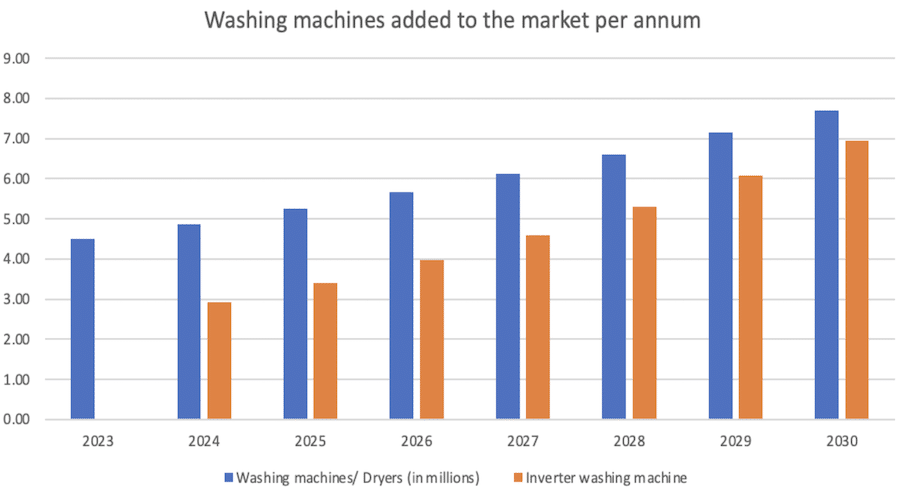
From 2023 to 2030, inverter-based fully-automatic washing machines are projected to consume 4.3 tera-watt hours of power. Inverter technology itself results in 20% energy savings over non-inverter models, and saves 0.86 tera-watt hours of electricity. If GaN replaces silicon, 5% more efficiency will be the result. Overall, 25% of energy savings will occur over non-inverter models with GaN, and 1.075 tera-watt hours are expected to be saved with GaN.
These 1.075 TWh of electricity saving translate to 913,750,000 Kg of carbon dioxide savings, or 0.9 MMT of emissions saved.
Consumer charging equipment
The European Union (EU) has passed an approval for the standardization of one universal charger for mobile phones and other portable electronic devices. The main aim of this effort is to reduce electronic waste, enhance consumer convenience, and promote sustainability in the use of electronic devices40. The universal charger makes it easier for consumers to use one charger for multiple devices, regardless of the brand or model. This move is expected to lead to a reduction in the number of chargers discarded and contribute to a circular economy by extending the lifespan of electronic products.
The idea of a universal charger had been a subject of discussion for the past decade in the parliament of the EU, with various efforts to encourage the adoption of common charging standards by different device manufacturers. However, voluntary efforts and measures failed to produce meaningful changes in Europe. With the EU’s proposal for this charger being passed in parliament, the standardization has become mandatory for all manufacturers within the EU market41.
The USB Type-C port will act as the new universal, standardized charger. By December of 2024, all mobile phones, tablets and cameras sold in the EU will have to be equipped with a USB Type-C charging port. From spring 2026, laptops will be included too.
The USB-C port is the best solution for a universal charger. Since the USB-C is a multifunctional connector capable of carrying both data and power, it can support various protocols, such as USB 3.1, Thunderbolt, DisplayPort, and more. This makes it suitable for a wide range of devices, including smartphones, tablets, laptops, monitors, and peripherals. It also has a reversible design, which means it can be plugged in either way, unlike the older USB-A and USB-B connectors. This makes it more user-friendly and eliminates consumers trying to figure out the correct orientation when connecting devices. The USB-C can deliver more power to charge larger devices like laptops and has high-speed data transfer capabilities42.
GaN has a major application in USB-C chargers. Belkin and Apple have already launched fast-chargers that incorporate GaN, and they have done very well. Belkin launched a 60 Watt GaN charger43. Apple launched a 70W GaN charger44. In fact, New Amber Group’s Research and Development facility in Greater Noida, Uttar Pradesh has also begun testing GaN in the USB-C. This is an initial step that builds up to manufacturing.
The primary advantage of GaN in chargers lies in its ability to generate lower heat. This reduced heat production allows for tighter component integration, enabling chargers to be more compact than ever before, while still retaining their full power capacity and adhering to safety standards45. GaN is on track to completely replace Silicon in charging. Components made from GaN facilitate faster electrical current flow compared to silicon, resulting in accelerated processing speeds. GaN’s enhanced efficiency is seen with reduced heat generation.
Many GaN USB-C chargers have already been sold in the US and other countries, but with the EU’s new universal charger mandate, countries across the world will follow with the same regulations. Even though the standardized charger regulation won’t be prevalent globally immediately, GaN based USB-C chargers have been predicted to be 50% of the global market by 202546.
Roadmap of USB-C chargers for mobile phones in India (each phone does not come with a charger):
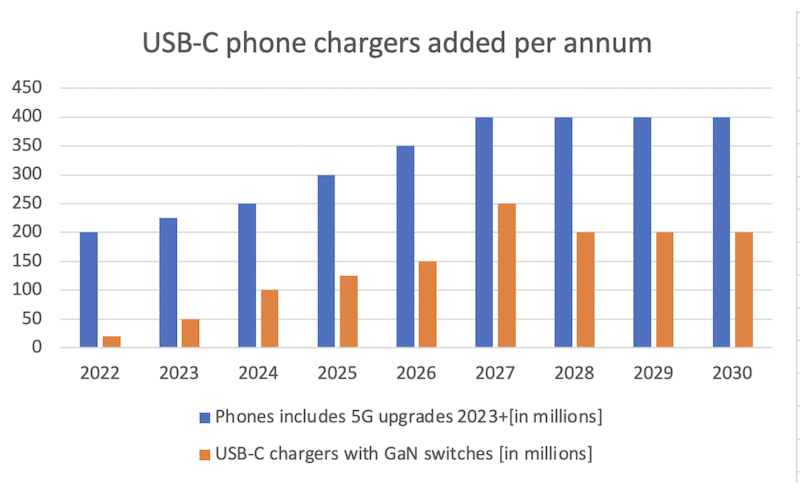
225 million mobile phones with 5G upgrades are projected to be added to the Indian market in 2023. For these, approximately 22% – 50 million – chargers will be GaN based. GaN based chargers will be 100 million, 40% of 250 million new mobile phones with 5G upgrades added in 2024, and 200 million, which is 50% of 400 million new mobile phones with 5G upgrades added to the Indian market in 2030. The total energy consumption by Gan USB-C chargers from 2023 to 2030 is projected to be 14.9 tera- watt hours. The energy savings with these chargers is 8% more than silicon- 1.19 tera- watt hours. These 1.19 tera-watt hours of energy savings translate to about 1,011,500,000 carbon dioxide emission savings.
Roadmap for USB-C chargers for laptops, tablets, e-notebooks in India (each of these devices comes with a USB-C charger):
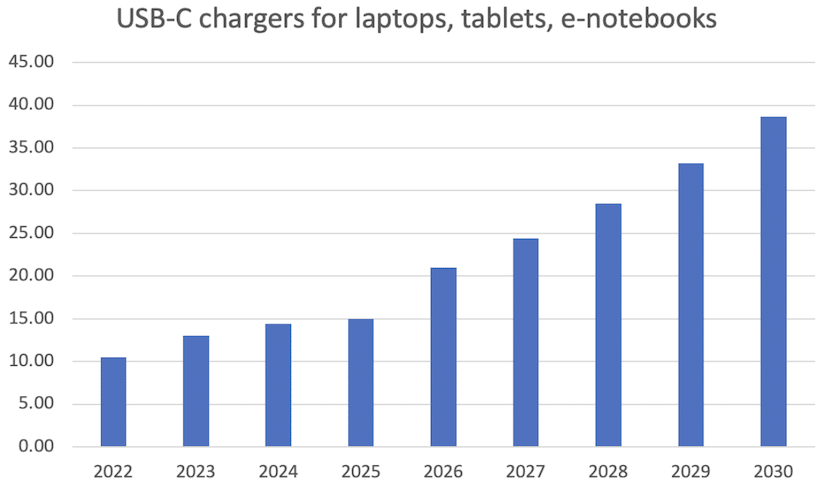
USB-C chargers for tablets, E-notebooks, and laptops adder per annum will grow from being approximately 13 million in 2023, to 38.68 million in 2030. The total energy consumption by these USB-C chargers from 2023 to 2030 is projected to be 2.82 tera- watt hours. The energy savings with these chargers is 10% more than silicon- 0.282 tera-watt hours.
These 0.282 TWh energy savings translate to about 239,700,000 Kg, or 0.24 MMT of carbon dioxide emission savings.
Solar Inverters
Both the USA and India have similar percentages of renewable energy consumption, with this figure being around 20%47. However, due to India’s significantly larger population and citizens’ energy consumption demands increasing astonishingly and as a developing country, India must take larger-scale and centrally planned solar initiatives.
Rooftop installations can be only initiated in city buildings or on farmhouses, where the solar electricity generated will be much less. Out of the 500 gigawatts of renewable energy capacity to be installed by 2030, 280 gigawatts are dedicated to solar energy plants.48 This target must be kept in mind, and large scale installations are what India can majorly focus on. Rooftops are only around 10% of all installations.
A major large-scale solar initiative was launched by the Indian government in 2010. It was The Jawaharlal Nehru National Solar Mission (JNNSM), a flagship solar energy program launched by the Government of India in 2010. Named after India’s first Prime Minister, Jawaharlal Nehru, the mission was part of the country’s efforts to promote renewable energy and reduce its dependence on fossil fuels to combat climate change and achieve energy security. The mission provided financial incentives such as subsidies, grants, and concessional financing to attract investments in solar projects and make solar power more affordable for consumers.
GaN inverters currently cannot be used in large-scale solar projects as such. This is because GaN inverters have 10-15% higher efficiency than alternatives at low power, not high power because the voltage rating of GaN devices today is 650V. Other compound semiconductors like Silicon carbide (SiC) currently have compatible “sweet spots” at the higher voltage rating of 1200V required for these applications. As GaN technology evolves to 1200V rating transistors the market share of SiC and GaN has to be re-evaluated at the time. GaN’s distributed design is more suited for India where solar farms are on smaller patches of land- such as rooftops or on farms, Rooftop installations remain a focus area in developed countries. Enphase, the world leading company for microinverters has announced its intent to switch completely from Si MOSFETs to GaN within this decade..Additional Government resources continue to be deployed in this area. The Biden administration’s inflation reduction act is an example. The US government has implemented federal-level initiatives, such as the Investment Tax Credit (ITC) and the Solar Investment Tax Credit (ITC), which offer tax incentives to homeowners and businesses for installing solar energy systems on rooftops. The Inflation reduction act also extends these benefits to nonprofit organizations like schools now49.
GaN inverters can be targeted for distribution in accordance with government initiatives for smaller solar patches. The Indian government has launched a robust initiative to add solar energy installations in 2018: Project KUSUM (Kisan Urja Suraksha evam Utthaan Mahaabhiyan). This project is a leading example of the government’s commitment to promote solar energy in the agriculture sector50. Project KUSUM sets the target to install 10,000 megawatt capacity of small solar power plants, 2 million standalone solar water pumps, and to solarize 1.5 million existing grid-connected agriculture pumps including through feeder level solarisation51.
This project facilitates the distribution of solar panels to farmers, enabling them to harness solar energy for self-consumption and income generation through surplus power sales. The government provides financial incentives and subsidies to farmers for adopting solar-powered pumps and solar panels, making renewable energy solutions more accessible and affordable. If farms generate surplus power through their solar installations, they can also earn additional income by selling electricity back to the grid due to KUSUM.
Project KUSUM has the potential to enhance farmers’ income, reduce greenhouse gas emissions, and is currently significantly contributing to India’s efforts in achieving its renewable energy targets- 50% renewable by 2030 and carbon neutral by 207052. Even though the initiative was significantly impacted by COVID and has been extended to 31st March, 2026, approximately 1140 megawatt of solar capacity has been installed due to PM-KUSUM so far53. As of 28th March 2023, Project KUSUM benefited 208,648 farmers across the country. Haryana, Rajasthan, Maharashtra, and Uttar Pradesh were the four states that have most benefitted from the project54.
Roadmap of rooftop and small solar installations in India:
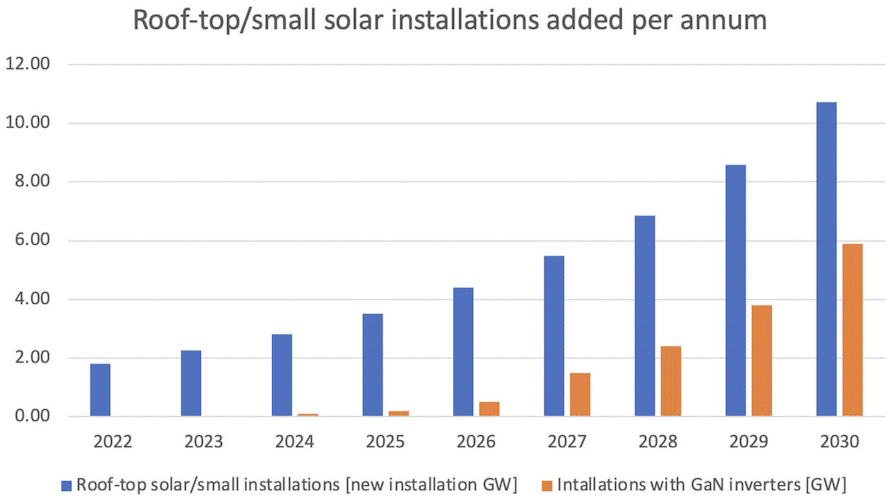
2.7 gigawatts of solar rooftop and small solar installations are projected to be installed in 2023. The total gigawatts of solar rooftop and small solar installations added is expected to be close to 46 gigawatts by 2030. The lifespan of a solar inverter is between 6 to 8 years, thus, it will take approximately 12 years to replace all inverters in use. GaN inverters are projected to make up almost 50% of all added small installations in 2030, but they won’t be introduced before 2024- where they will only account for 0.1 gigawatt of energy consumed. If the volume of installed GaN inverters increases as predicted, out of the cumulative 46.4 gigawatt of added installations through these inverters, 14.4 gigawatt is of GaN inverters. On average, a solar inverter is used for 250 days a year, 6 hours a day, consuming 21,600 GW hours of energy. Out of this, 7% energy – 1512 gigawatt- savings over silicon occur. This is 1.5 TWh of saving in total by 2030.
The 1.5 TWh energy savings translates to 1,275,000,000, or 1.275 MMT of carbon dioxide emission savings.
Segment Summary
For the six segments studied in this report, the highest energy savings are projected to be in the order below:
- Refrigerators: 8.5TWh
- Onboard chargers in Automotive industry: 7.22 TWh
- Airconditioners: 6.95TWh
- Solar inverters (rooftop and small installations): 1.5 TWh
- USB-C chargers: 1.472 TWh
- Washing machines: 1.075TWh
Breakup of savings across the 6 segments:
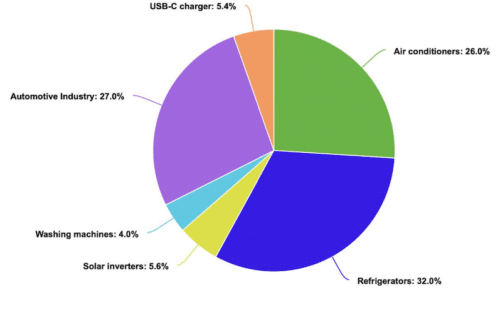
Refrigerators, the automotive industry, and air conditioning are the three leading segments in terms of savings with GaN out of all categories included in this report. 85% of savings are in these three segments alone.
That being said, immense amounts of savings in the solar segment will occur with the adoption of other compound semiconductor devices in large-scale, high-voltage range projects. For rooftop and small solar installations, GaN based installations can increase and compose a significantly higher proportion of all installations in a larger timeframe, such as by 2040.
USB-C chargers added to the market are also expected to increase at higher rates after 2030, the time frame of the report. This is because global spread and effects of the European Union’s legislative actions will occur after at least 3 to 5 years of the change, which will be made in 2024.
Based on the Central Electricity Authority of India’s 6th version of the emission factor database, where 1 kWh of electricity translates to 0.85 Kg of carbon dioxide emissions, the total carbon dioxide savings are estimated to be 22 million metric tons (MMT), with the adoption of GaN across these 6 segments. In simple terms, these savings of carbon dioxide emissions are equivalent to the emissions of:
- 5,050,325 gasoline-powered passenger vehicles driven for one year
- 9,666,920,271.1035 liters of gasoline consumed
- 11,531,171,822.8136 kilograms of coal burned
- 2,760,679,857,685 of smartphones fully charged
Even though there is no large-scale production of GaN switches in India as of July 2023, manufacturers such as Amber have begun testing GaN in its more established applications, such as in USB-C chargers. Other industry experts who have not yet tested GaN still know of the semiconductor material, and are ready to foment change in their products, using India’s natural resources’ compatibility with GaN production, once GaN has gained recognition for efficiency and feasibility for both the supply-side and demand-side of the market on a global scale.
| Preface I am grateful for the guidance provided by a distinguished group of experts in the field of power electronics and gallium nitride technology throughout the course of my research internship with Global Trade Observer (GTO). I have been supported by my advisor, Dr. Harsha Vardhana Singh, whose mentorship and encouragement have been instrumental in this initiative. Furthermore, Dr. Umesh Mishra and Dr. Rakesh Lal from Transphorm, a United States- based manufacturer of gallium nitride transistors, have helped shape my research by providing their insights and contributions to my findings. I am also thankful and acknowledge the support and cooperation of several executives from prominent Indian companies including Minda Auto, Amber Enterprises, Dixon Electronics, and Delta Electronics. Their involvement in power electronics research and gallium nitride has been crucial in providing practical feedback into the potential applications of this technology in the Indian landscape. The purpose of this report is for GTO to build on my research and present their findings to the Government of India, as an initial step towards fostering further investigation into the promising realm of green energy. Additionally, the report’s intent is to raise awareness about the pivotal role that compound semiconductors, particularly gallium nitride, play in enhancing energy efficiency. It is my hope that this report can start collaboration between investors, government agencies, and research institutions in India to pave the way for a sustainable and energy-efficient future. |
Aaryaman Rathor is working as a Research Intern at Global Trade Observer
References:
1 Ministry of Power, Government of India. “Power Sector at a Glance – All India.” Power Ministry, https://powermin.gov.in/en/content/power-sector-glance-all-india.
2 Chart: How Much of India’s Electricity Is Generated From Renewable Sources?, https://thewire.in/energy/chart-india-renewable-energy-generation, The Wire
3 IEA. “India’s Clean Energy Transition Is Rapidly Underway, Benefiting the Entire World.” International Energy Agency,, https://www.iea.org/commentaries/india-s-clean-energy-transition-is-rapidly-underway- benefiting-the-entire-world.
4 Solar and wind dominate India’s capacity additions in 2022, https://ember- climate.org/insights/research/india-data-story- 2023/#:~:text=Solar%20and%20wind%20dominated%20India%27s,and%20wind%20capacity%20additio ns%20increased, Ember
5 Solar and wind dominate India’s capacity additions in 2022, https://ember- climate.org/insights/research/india-data-story- 2023/#:~:text=Solar%20and%20wind%20dominated%20India%27s,and%20wind%20capacity%20additio ns%20increased, Ember
6 IEA. “India’s Clean Energy Transition Is Rapidly Underway, Benefiting the Entire World.” International Energy Agency,, https://www.iea.org/commentaries/india-s-clean-energy-transition-is-rapidly-underway- benefiting-the-entire-world.
7 Future Trends of the Power or Energy Sector in India, htps://solarismypassion.com/solar-blogs/future- trends-of-the-power-or-energy-sector-in-india/
8 Plan to install 500 GW of renewable energy capacity by 2030 to cost ₹2.44 trillion, https://www.thehindu.com/news/national/cost-of-transmitting-clean-energy-in-india-to-exceed-2- trillion/article66235468.ece, The Hindu
9 Energy storage capacity, https://www.thehindubusinessline.com/economy/india-to-have-41-gw-of-energy-storage-capacity-by- 2030-says- govt/article66815173.ece#:~:text=India%20is%20projected%20to%20have,Ministry%20of%20Power%2C %20on%20Wednesday, Hindu Business
10 Ministry of Power, Government of India. “Power Sector at a Glance – All India.” Power Ministry, https://powermin.gov.in/en/content/power-sector-glance-all-india.
11 Understanding the sweet spots for GaN and SiC technologies, https://www.embedded.com/understanding-the-sweet-spots-for-gan-and-sic- technologies/#:~:text=Sweet%20spots%20for%20SiC%20and%20GaN&text=“GaN%20semiconductors% 20usually%20span%2050,40%20V%20to%2050%20V, Embedded.com
12 Recent Advance and Future Progress of GaN Power Semiconductor Devices, https://www.researchgate.net/publication/329648047_Recent_Advance_and_Future_Progress_of_GaN_ Power_Semiconductor_Devices_Used_in_PV_Module_Integrated_Converters, Research Gate
13 Indian Bureau of Mines Nagpur, https://ibm.gov.in/IBMPortal/
14 Hirandanis expect nod for chip fab project in 2 months, www.financialexpress.com, Financial Express
15 Gallium Nitride Semiconductor Device Market Growth, Opportunities and Industry Trends, https://www.marketsandmarkets.com/Market-Reports/gallium-nitride-gan-semiconductor-materials- devices-market- 698.html#:~:text=Who%20are%20the%20key%20players,under%20the%20key%20players%20category, MarketsandMarkets
16 Infineon to acquire Gan Systems, https://www.infineon.com/cms/en/about-infineon/press/press- releases/2023/INFXX202303-073.html, Infineon
17 How can smart charging steer electric vehicle uptake in India? – Analysis, https://www.iea.org/commentaries/how-can-smart-charging-steer-electric-vehicle-uptake-in- india#:~:text=The%20government%20of%20India%20supports,manufacturing%20capacity%20at%20glo bal%20scale, IEA
18 How data is fueling the growth for Electric Vehicles in India, https://www.businesstoday.in/opinion/columns/story/how-data-is-fueling-the-growth-for-electric-vehicles- in-india-384416-2023-06- 06#:~:text=The%20sector%20has%20already%20attracted,touch%20%24150%20billion%20by%202030, Business Today
19 Electric Vehicles: The Advantages and Challenges, https://www.drishtiias.com/daily-updates/daily- news-editorials/electric-vehicles-the-advantages-and-challenges, Drishti IAS
20 What Is an Onboard Charger?, https://www.aptiv.com/en/insights/article/what-is-an-onboard-charger, Mobility Insider
21 What Is an Onboard Charger?, https://www.aptiv.com/en/insights/article/what-is-an-onboard-charger, Mobility Insider
22 Charging infrastructure needs big push as EV adoption grows in India, https://energy.economictimes.indiatimes.com/news/power/charging-infrastructure-needs-big-push-as-ev- adoption-grows-in-india/97239350, ET Energy World
23 CO2 emission factor database, version 06 CEA (Government of India) http://www.cea.nic.in/reports/planning/cdm_co2/cdm_co2.htm
24 India’s energy policies drive AC efficiency gains and inverter tech adoption: Report, https://www.livemint.com/news/india/indias-energy-efficiency-policies-boost-ac-efficiency-by-61-bee-data- shows-accelerated-adoption-of-inverter-technology-in-new-delhi-11683712894779.html, Mint
25 India Air Conditioner Market Report 2023: Increasing Demand from the Residential Sector Bolsters Growth, https://www.globenewswire.com/en/news-release/2023/03/30/2637442/28124/en/India-Air- Conditioner-Market-Report-2023-Increasing-Demand-from-the-Residential-Sector-Bolsters- Growth.html#:~:text=The%20Indian%20government%27s%20initiatives%20to,for%20higher%2Drated%2 0split%20ACs., Global Newswire
26 India Air Conditioner Market Report 2023: Increasing Demand from the Residential Sector Bolsters Growth, https://www.globenewswire.com/en/news-release/2023/03/30/2637442/28124/en/India-Air- Conditioner-Market-Report-2023-Increasing-Demand-from-the-Residential-Sector-Bolsters- Growth.html#:~:text=The%20Indian%20government%27s%20initiatives%20to,for%20higher%2Drated%2 0split%20ACs., Global Newswire
27 Bureau of Energy Efficiency, https://www.beestarlabel.com
28 Research and Development, https://www.ambergroupindia.com/research-and-development/, New Amber Group
29 Research and Development, https://www.ambergroupindia.com/research-and-development/, New Amber Group
30 Bureau of Energy Efficiency, https://www.beestarlabel.com
31 Indians are becoming more energy conscious in their choice for home appliances, https://economictimes.indiatimes.com/industry/cons-products/durables/indians-are-becoming-more- energy-conscious-in-their-choice-for-home-appliances/articleshow/101861492.cms, The Economic Times
32 Indians are becoming more energy conscious in their choice for home appliances, https://economictimes.indiatimes.com/industry/cons-products/durables/indians-are-becoming-more- energy-conscious-in-their-choice-for-home-appliances/articleshow/101861492.cms, The Economic Times
33 Indians are becoming more energy conscious in their choice for home appliances, https://economictimes.indiatimes.com/industry/cons-products/durables/indians-are-becoming-more- energy-conscious-in-their-choice-for-home-appliances/articleshow/101861492.cms, The Economic Times
34 Govt considers curbing fridge imports to boost local industry: Report, https://www.businesstoday.in/latest/story/govt-considers-curbing-fridge-imports-to-boost-local-industry- report-336948-2022-06-09, Business Today
35 India Washing Machine Market Size & Share Analysis – Industry Research Report – Growth Trends, https://www.mordorintelligence.com/industry-reports/india-washing-machine-market
36Changing Lifestyles Influencing Indian Consumers: Conceptualizing, https://www.ripublication.com/gjmbs_spl/gjmbsv3n8_06.pdf
37 Bureau of Energy Efficiency, https://www.beestarlabel.com
38 India Washing Machine Market Size & Share Analysis – Industry Research Report – Growth Trends, https://www.mordorintelligence.com/industry-reports/india-washing-machine-market
39 Automatic Washing Machine, Voltage, https://www.exportersindia.com/product-detail/110v-220v- automatic-washing-machine-4980309.htm#:~:text=Piece%20in%20Kolkata- ,Automatic%20Washing%20Machine%2C%20Voltage%20%3A%20110V%2C%20220V%2C%20380%2 C,h%2C%2050%2D100kg%2Fh
40 Long-awaited common charger for mobile devices will be a reality in 2024, https://www.europarl.europa.eu/news/en/press-room/20220930IPR41928/long-awaited-common-charger- for-mobile-devices-will-be-a-reality-in-2024, Europa Parliament
41 Long-awaited common charger for mobile devices will be a reality in 2024, https://www.europarl.europa.eu/news/en/press-room/20220930IPR41928/long-awaited-common-charger- for-mobile-devices-will-be-a-reality-in-2024, Europa Parliament
42 What is USB-C and what benefits does it bring?, https://ganfast.com/what-is-usb-c-and-what-benefits- does-it- bring/#:~:text=The%20USB%20type%20C%20connector,and%20high%2Dspeed%20external%20storag e, GaN Fast
43 GaN Chargers: Belkin: US, https://www.belkin.com/products/product-resources/gan-chargers/, Belkin
44 70W USB-C Power Adapter, https://www.apple.com/in/shop/product/MQLN3HN/A/70w-usb-c-power- adapter, Apple India
45 GaN Chargers: Belkin: US, https://www.belkin.com/products/product-resources/gan-chargers/, Belkin
46 GaN-based fast chargers to be 50% of Market in 2025, https://compoundsemiconductor.net/article/113764/GaN- based_fast_chargers_to_be_50_of_Market_in_2025, Compound Semiconductor
47 Office of Energy Efficiency & Renewable Energy, https://www.energy.gov/eere/office-energy-efficiency- renewable-energy, Energy.gov
48 Future Trends of the Power or Energy Sector in India, https://solarismypassion.com/solar-blogs/future- trends-of-the-power-or-energy-sector-in-india/
49 Inflation Reduction Act Guidebook, https://www.whitehouse.gov/cleanenergy/inflation-reduction-act- guidebook/, The White House
50 National Portal of India, https://www.india.gov.in/spotlight/pm-kusum-pradhan-mantri-kisan-urja- suraksha-evam-utthaan-mahabhiyan-scheme
51 Renewable Energy Policy, https://vikaspedia.in/energy/policy-support/renewable-energy-1/solar- energy/pm-kusum- scheme#:~:text=Ministry%20of%20New%20and%20Renewable,power%20plants%20in%20the%20count ry, Vikaspedia
52 Nearly 21 lakh farmers have benefitted from PM-KUSUM: Union Power & NRE Minister Shri R. K. Singh, https://pib.gov.in/PressReleasePage.aspx?PRID=1911480, Press Information Bureau
53 Over 200,000 Farmers Have Benefited from PM-KUSUM: Power Minister – Mercom India, https://www.mercomindia.com/over-200000-farmers-pm-kusum-power-minister, Mercom India
54 Over 200,000 Farmers Have Benefited from PM-KUSUM: Power Minister – Mercom India, https://www.mercomindia.com/over-200000-farmers-pm-kusum-power-minister, Mercom India








